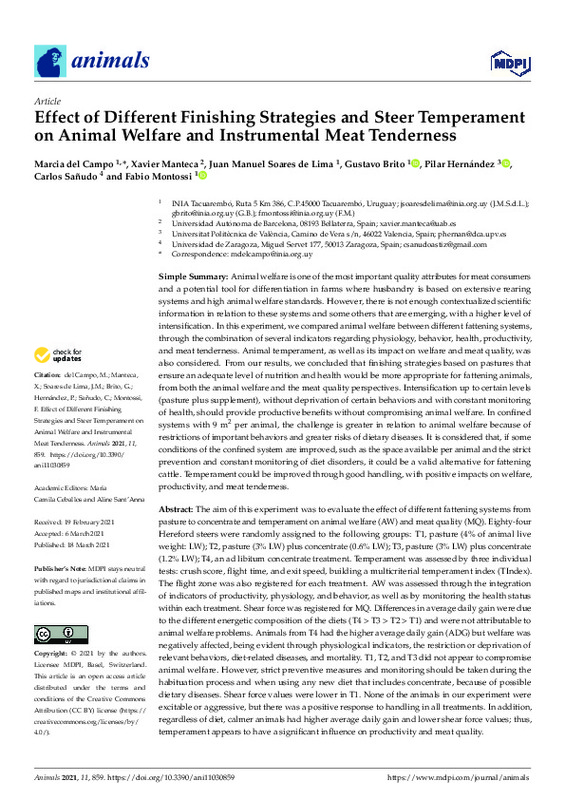JavaScript is disabled for your browser. Some features of this site may not work without it.
Buscar en RiuNet
Listar
Mi cuenta
Estadísticas
Ayuda RiuNet
Admin. UPV
Effect of Different Finishing Strategies and Steer Temperament on Animal Welfare and Instrumental Meat Tenderness
Mostrar el registro sencillo del ítem
Ficheros en el ítem
| dc.contributor.author | del Campo, Marcia
|
es_ES |
| dc.contributor.author | Manteca, Xavier
|
es_ES |
| dc.contributor.author | Soares de Lima, Juan Manuel
|
es_ES |
| dc.contributor.author | Brito, Gustavo
|
es_ES |
| dc.contributor.author | Hernández, Pilar
|
es_ES |
| dc.contributor.author | Sañudo, Carlos
|
es_ES |
| dc.contributor.author | Montossi, Fabio
|
es_ES |
| dc.date.accessioned | 2022-05-30T18:05:01Z | |
| dc.date.available | 2022-05-30T18:05:01Z | |
| dc.date.issued | 2021-03 | es_ES |
| dc.identifier.uri | http://hdl.handle.net/10251/182988 | |
| dc.description.abstract | [EN] Animal welfare is one of the most important quality attributes for meat consumers and a potential tool for differentiation in farms where husbandry is based on extensive rearing systems and high animal welfare standards. However, there is not enough contextualized scientific information in relation to these systems and some others that are emerging, with a higher level of intensification. In this experiment, we compared animal welfare between different fattening systems, through the combination of several indicators regarding physiology, behavior, health, productivity, and meat tenderness. Animal temperament, as well as its impact on welfare and meat quality, was also considered. From our results, we concluded that finishing strategies based on pastures that ensure an adequate level of nutrition and health would be more appropriate for fattening animals, from both the animal welfare and the meat quality perspectives. Intensification up to certain levels (pasture plus supplement), without deprivation of certain behaviors and with constant monitoring of health, should provide productive benefits without compromising animal welfare. In confined systems with 9 m(2) per animal, the challenge is greater in relation to animal welfare because of restrictions of important behaviors and greater risks of dietary diseases. It is considered that, if some conditions of the confined system are improved, such as the space available per animal and the strict prevention and constant monitoring of diet disorders, it could be a valid alternative for fattening cattle. Temperament could be improved through good handling, with positive impacts on welfare, productivity, and meat tenderness. The aim of this experiment was to evaluate the effect of different fattening systems from pasture to concentrate and temperament on animal welfare (AW) and meat quality (MQ). Eighty-four Hereford steers were randomly assigned to the following groups: T1, pasture (4% of animal live weight: LW); T2, pasture (3% LW) plus concentrate (0.6% LW); T3, pasture (3% LW) plus concentrate (1.2% LW); T4, an ad libitum concentrate treatment. Temperament was assessed by three individual tests: crush score, flight time, and exit speed, building a multicriterial temperament index (TIndex). The flight zone was also registered for each treatment. AW was assessed through the integration of indicators of productivity, physiology, and behavior, as well as by monitoring the health status within each treatment. Shear force was registered for MQ. Differences in average daily gain were due to the different energetic composition of the diets (T4 > T3 > T2 > T1) and were not attributable to animal welfare problems. Animals from T4 had the higher average daily gain (ADG) but welfare was negatively affected, being evident through physiological indicators, the restriction or deprivation of relevant behaviors, diet-related diseases, and mortality. T1, T2, and T3 did not appear to compromise animal welfare. However, strict preventive measures and monitoring should be taken during the habituation process and when using any new diet that includes concentrate, because of possible dietary diseases. Shear force values were lower in T1. None of the animals in our experiment were excitable or aggressive, but there was a positive response to handling in all treatments. In addition, regardless of diet, calmer animals had higher average daily gain and lower shear force values; thus, temperament appears to have a significant influence on productivity and meat quality. | es_ES |
| dc.description.sponsorship | This research was financed by INIA Uruguay and received no external funding. | es_ES |
| dc.language | Inglés | es_ES |
| dc.publisher | MDPI AG | es_ES |
| dc.relation.ispartof | Animals | es_ES |
| dc.rights | Reconocimiento (by) | es_ES |
| dc.subject | Steers | es_ES |
| dc.subject | Temperament | es_ES |
| dc.subject | Acute phase proteins | es_ES |
| dc.subject | Fecal glucocorticoids | es_ES |
| dc.subject | Meat tenderness | es_ES |
| dc.subject.classification | PRODUCCION ANIMAL | es_ES |
| dc.title | Effect of Different Finishing Strategies and Steer Temperament on Animal Welfare and Instrumental Meat Tenderness | es_ES |
| dc.type | Artículo | es_ES |
| dc.identifier.doi | 10.3390/ani11030859 | es_ES |
| dc.rights.accessRights | Abierto | es_ES |
| dc.contributor.affiliation | Universitat Politècnica de València. Departamento de Ciencia Animal - Departament de Ciència Animal | es_ES |
| dc.description.bibliographicCitation | Del Campo, M.; Manteca, X.; Soares De Lima, JM.; Brito, G.; Hernández, P.; Sañudo, C.; Montossi, F. (2021). Effect of Different Finishing Strategies and Steer Temperament on Animal Welfare and Instrumental Meat Tenderness. Animals. 11(3):1-21. https://doi.org/10.3390/ani11030859 | es_ES |
| dc.description.accrualMethod | S | es_ES |
| dc.relation.publisherversion | https://doi.org/10.3390/ani11030859 | es_ES |
| dc.description.upvformatpinicio | 1 | es_ES |
| dc.description.upvformatpfin | 21 | es_ES |
| dc.type.version | info:eu-repo/semantics/publishedVersion | es_ES |
| dc.description.volume | 11 | es_ES |
| dc.description.issue | 3 | es_ES |
| dc.identifier.eissn | 2076-2615 | es_ES |
| dc.identifier.pmid | 33803519 | es_ES |
| dc.identifier.pmcid | PMC8002882 | es_ES |
| dc.relation.pasarela | S\448860 | es_ES |
| dc.contributor.funder | Instituto Nacional de Investigación Agropecuaria, Uruguay | es_ES |








